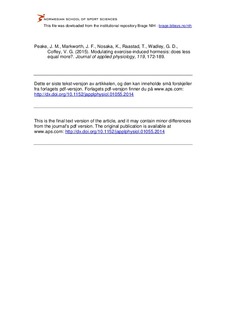| dc.contributor.author | Peake, Jonathan M. | |
| dc.contributor.author | Markworth, James F. | |
| dc.contributor.author | Nosaka, Kazunori | |
| dc.contributor.author | Raastad, Truls | |
| dc.contributor.author | Wadley, Glenn D. | |
| dc.contributor.author | Coffey, Vernon G. | |
| dc.date.accessioned | 2016-08-30T06:45:18Z | |
| dc.date.available | 2016-08-30T06:45:18Z | |
| dc.date.issued | 2015-08-01 | |
| dc.identifier.citation | Journal of Applied Physiology. 2015, 119, 172-189 | nb_NO |
| dc.identifier.uri | http://hdl.handle.net/11250/2402602 | |
| dc.description | Dette er siste tekst-versjon av artikkelen, og den kan inneholde små forskjeller fra forlagets pdf-versjon. Forlagets pdf-versjon finner du på www.aps.com / This is the final text version of the article, and it may contain minor differences from the journal's pdf version. The original publication is available at www.aps.com | nb_NO |
| dc.description.abstract | Hormesis encompasses the notion that low levels of stress stimulate or upregulate existing cellular and molecular pathways that improve the capacity of cells and organisms to withstand greater stress. This notion underlies much of what we know about how exercise conditions the body and induces long-term adaptations. During exercise, the body is exposed to various forms of stress, including thermal, metabolic, hypoxic, oxidative, and mechanical stress. These stressors activate biochemical messengers, which in turn activate various signaling pathways that regulate gene expression and adaptive responses. Historically, antioxidant supplements, nonsteroidal anti-inflammatory drugs, and cryotherapy have been favored to attenuate or counteract exercise-induced oxidative stress and inflammation. However, reactive oxygen species and inflammatory mediators are key signaling molecules in muscle, and such strategies may mitigate adaptations to exercise. Conversely, withholding dietary carbohydrate and restricting muscle blood flow during exercise may augment adaptations to exercise. In this review article, we combine, integrate, and apply knowledge about the fundamental mechanisms of exercise adaptation. We also critically evaluate the rationale for using interventions that target these mechanisms under the overarching concept of hormesis. There is currently insufficient evidence to establish whether these treatments exert dose-dependent effects on muscle adaptation. However, there appears to be some dissociation between the biochemical/molecular effects and functional/performance outcomes of some of these treatments. Although several of these treatments influence common kinases, transcription factors, and proteins, it remains to be determined if these interventions complement or negate each other, and whether such effects are strong enough to influence adaptations to exercise. | nb_NO |
| dc.language.iso | eng | nb_NO |
| dc.publisher | American Physiological Society | nb_NO |
| dc.subject | adaptation | nb_NO |
| dc.subject | stress | nb_NO |
| dc.subject | preconditioning | nb_NO |
| dc.title | Modulating exercise-induced hormesis: does less equal more? | nb_NO |
| dc.type | Journal article | nb_NO |
| dc.type | Peer reviewed | nb_NO |
| dc.subject.nsi | VDP::Mathematics and natural science: 400::Basic biosciences: 470 | nb_NO |
| dc.subject.nsi | VDP::Medical disciplines: 700::Basic medical, dental and veterinary science disciplines: 710 | nb_NO |
| dc.source.journal | Journal of Applied Physiology | nb_NO |
| dc.identifier.doi | 10.1152/japplphysiol.01055.2014 | |
| dc.description.localcode | Seksjon for fysisk prestasjonsevne / Department of Physical Performance | nb_NO |
